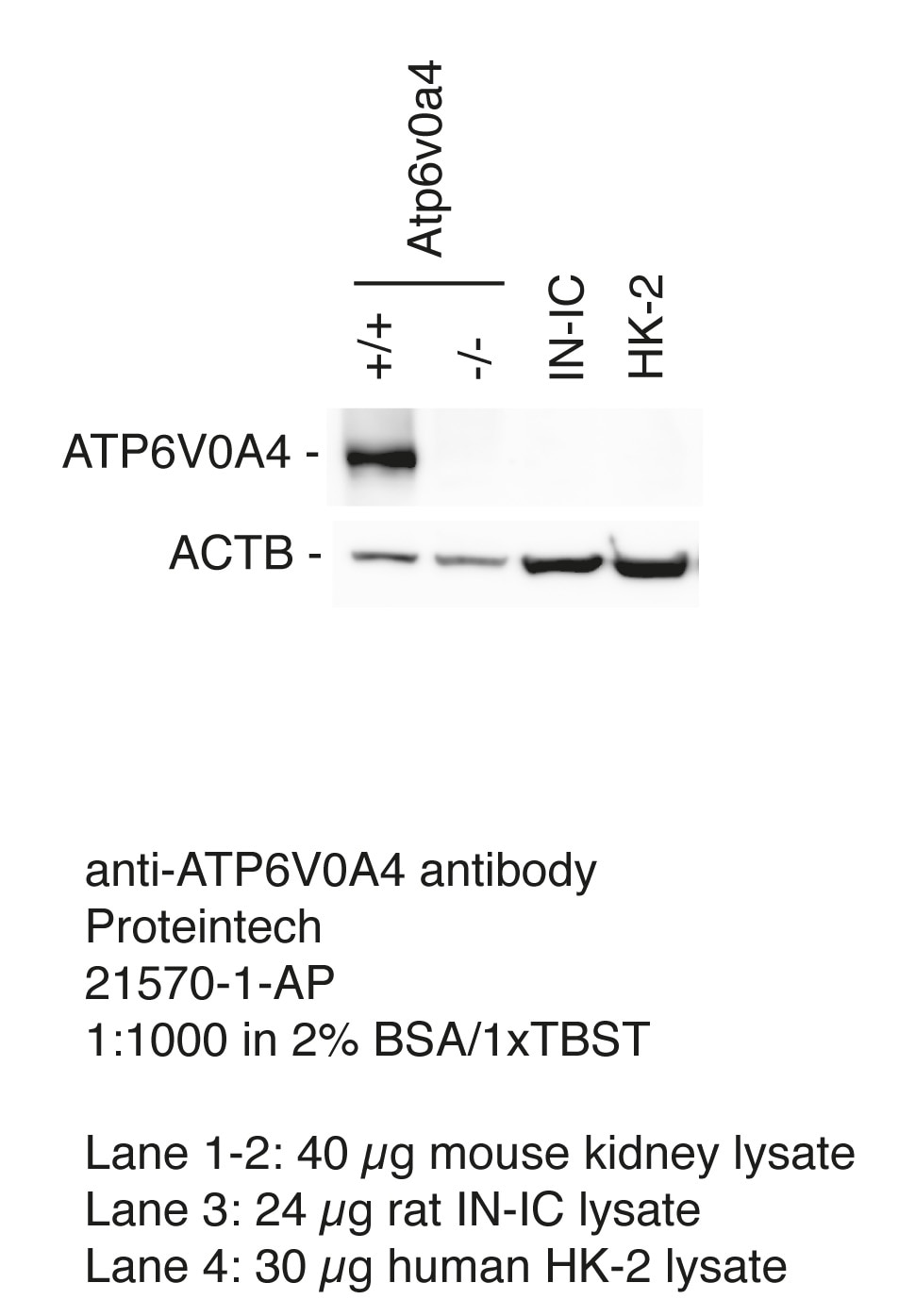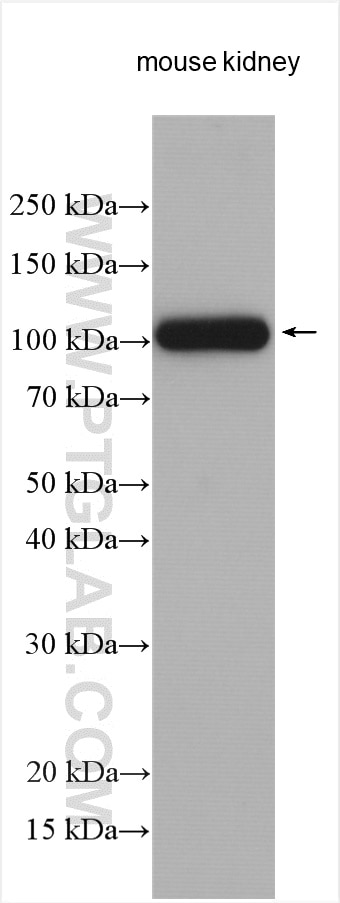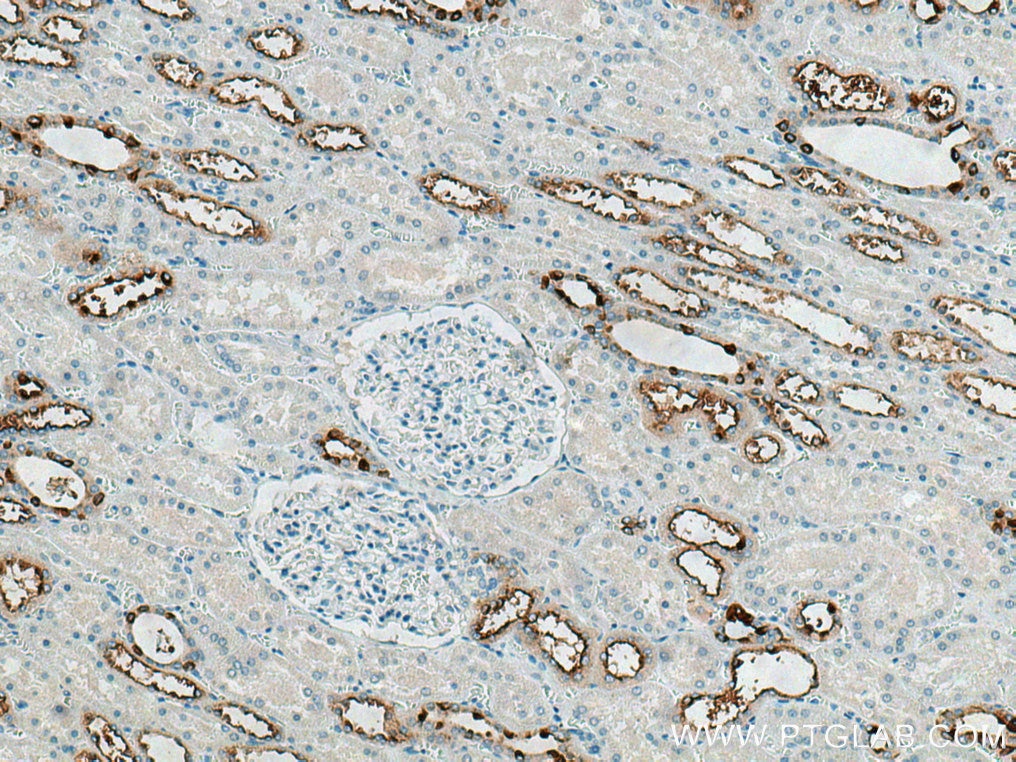- Phare
- Validé par KD/KO
Anticorps Polyclonal de lapin anti-ATP6V0A4
ATP6V0A4 Polyclonal Antibody for WB, IHC, ELISA
Hôte / Isotype
Lapin / IgG
Réactivité testée
Humain, souris
Applications
WB, IHC, IF, ELISA
Conjugaison
Non conjugué
N° de cat : 21570-1-AP
Synonymes
Galerie de données de validation
Applications testées
| Résultats positifs en WB | tissu rénal de souris, |
| Résultats positifs en IHC | tissu rénal humain, il est suggéré de démasquer l'antigène avec un tampon de TE buffer pH 9.0; (*) À défaut, 'le démasquage de l'antigène peut être 'effectué avec un tampon citrate pH 6,0. |
Dilution recommandée
| Application | Dilution |
|---|---|
| Western Blot (WB) | WB : 1:500-1:2000 |
| Immunohistochimie (IHC) | IHC : 1:50-1:500 |
| It is recommended that this reagent should be titrated in each testing system to obtain optimal results. | |
| Sample-dependent, check data in validation data gallery | |
Applications publiées
| WB | See 2 publications below |
| IHC | See 1 publications below |
| IF | See 1 publications below |
Informations sur le produit
21570-1-AP cible ATP6V0A4 dans les applications de WB, IHC, IF, ELISA et montre une réactivité avec des échantillons Humain, souris
| Réactivité | Humain, souris |
| Réactivité citée | Humain, souris |
| Hôte / Isotype | Lapin / IgG |
| Clonalité | Polyclonal |
| Type | Anticorps |
| Immunogène | ATP6V0A4 Protéine recombinante Ag16095 |
| Nom complet | ATPase, H+ transporting, lysosomal V0 subunit a4 |
| Masse moléculaire calculée | 840 aa, 96 kDa |
| Poids moléculaire observé | 100 kDa |
| Numéro d’acquisition GenBank | BC109305 |
| Symbole du gène | ATP6V0A4 |
| Identification du gène (NCBI) | 50617 |
| Conjugaison | Non conjugué |
| Forme | Liquide |
| Méthode de purification | Purification par affinité contre l'antigène |
| Tampon de stockage | PBS with 0.02% sodium azide and 50% glycerol |
| Conditions de stockage | Stocker à -20°C. Stable pendant un an après l'expédition. L'aliquotage n'est pas nécessaire pour le stockage à -20oC Les 20ul contiennent 0,1% de BSA. |
Informations générales
The ATP6V0A4 is a component of vacuolar-H+ATPase (V-ATPase) which is a multi-subunit enzyme that couples ATP hydrolysis to proton pumping across membranes. The V-ATPases are comprised of two major parts, the cytosolic V1 domain involved in ATP-binding and subsequent hydrolysis, and the membrane-associated V0 domain responsible for proton translocation. The V0 domain is composed of five subunits: a, c, c', c'' and d. The 'a' subunit of V0 domain has four isoforms : a1-a4. It has been found that mutations in ATP6V0A4(a4) are associated with distal renal tubular acidosis(dRTA) combined in some cases with progressive hearing loss leading to sensorineural deafness. This antibody was generated against the internal region of human ATP6V0A4 and is predicted to detect the a4 isoform only.
Protocole
| Product Specific Protocols | |
|---|---|
| WB protocol for ATP6V0A4 antibody 21570-1-AP | Download protocol |
| IHC protocol for ATP6V0A4 antibody 21570-1-AP | Download protocol |
| Standard Protocols | |
|---|---|
| Click here to view our Standard Protocols |
Publications
| Species | Application | Title |
|---|---|---|
Oncol Lett Identification of ATP6V0A4 as a potential biomarker in renal cell carcinoma using integrated bioinformatics analysis | ||
Function (Oxf) Dmxl1 is an Essential Mammalian Gene that is Required for V-ATPase Assembly and Function In Vivo | ||
Nat Commun Lysosomal NKG7 restrains mTORC1 activity to promote CD8+ T cell durability and tumor control |
Avis
The reviews below have been submitted by verified Proteintech customers who received an incentive for providing their feedback.
FH Christopher (Verified Customer) (12-14-2020) | We used the anti-ATP6V0A4 antibody. In lysates of homozygous Atp6v0a4-KO mice (described in Hennings et al., EMBO Mol Med, 2012) the signal for ATP6V0A4 was not detected anymore. Thus, the antibody is specific and does not cross-react.
 |



